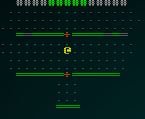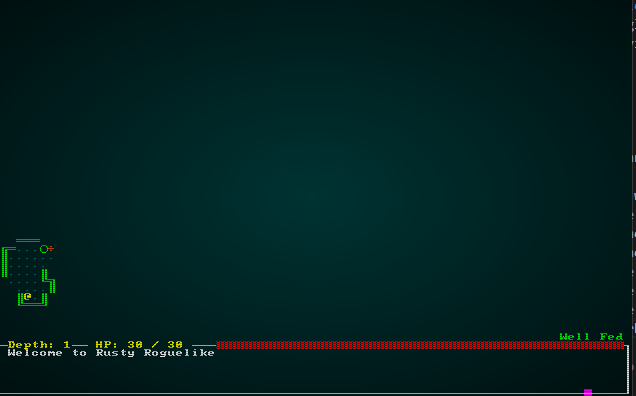Doors
About this tutorial
This tutorial is free and open source, and all code uses the MIT license - so you are free to do with it as you like. My hope is that you will enjoy the tutorial, and make great games!
If you enjoy this and would like me to keep writing, please consider supporting my Patreon.
Doors and corners, that's where they get you. If we're ever going to make Miller's (from The Expanse - probably my favorite sci-fi novel series of the moment) warning come true - it would be a good idea to have doors in the game. Doors are a staple of dungeon-bashing! We've waited this long to implement them so as to ensure that we have good places to put them.
Doors are an entity, too
We'll start with simple, cosmetic doors that don't do anything at all. This will let us work on placing them appropriately, and then we can implement some door-related functionality. It's been a while since we added an entity type; fortunately, we have everything we need for cosmetic doors in the existing components. Open up spawner.rs, and refamiliarize yourself with it! Then we'll add a door spawner function:
#![allow(unused)] fn main() { fn door(ecs: &mut World, x: i32, y: i32) { ecs.create_entity() .with(Position{ x, y }) .with(Renderable{ glyph: rltk::to_cp437('+'), fg: RGB::named(rltk::CHOCOLATE), bg: RGB::named(rltk::BLACK), render_order: 2 }) .with(Name{ name : "Door".to_string() }) .marked::<SimpleMarker<SerializeMe>>() .build(); } }
So our cosmetic-only door is pretty simple: it has a glyph (+ is traditional in many roguelikes), is brown, and it has a Name and a Position. That's really all we need to make them appear on the map! We'll also modify spawn_entity to know what to do when given a Door to spawn:
#![allow(unused)] fn main() { match spawn.1.as_ref() { "Goblin" => goblin(ecs, x, y), "Orc" => orc(ecs, x, y), "Health Potion" => health_potion(ecs, x, y), "Fireball Scroll" => fireball_scroll(ecs, x, y), "Confusion Scroll" => confusion_scroll(ecs, x, y), "Magic Missile Scroll" => magic_missile_scroll(ecs, x, y), "Dagger" => dagger(ecs, x, y), "Shield" => shield(ecs, x, y), "Longsword" => longsword(ecs, x, y), "Tower Shield" => tower_shield(ecs, x, y), "Rations" => rations(ecs, x, y), "Magic Mapping Scroll" => magic_mapping_scroll(ecs, x, y), "Bear Trap" => bear_trap(ecs, x, y), "Door" => door(ecs, x, y), _ => {} } }
We won't add doors to the spawn tables; it wouldn't make a lot of sense for them to randomly appear in rooms!
Placing doors
We'll create a new builder (we're still in the map section, after all!) that can place doors. So in map_builders, make a new file: door_placement.rs:
#![allow(unused)] fn main() { use super::{MetaMapBuilder, BuilderMap }; use rltk::RandomNumberGenerator; pub struct DoorPlacement {} impl MetaMapBuilder for DoorPlacement { #[allow(dead_code)] fn build_map(&mut self, rng: &mut rltk::RandomNumberGenerator, build_data : &mut BuilderMap) { self.doors(rng, build_data); } } impl DoorPlacement { #[allow(dead_code)] pub fn new() -> Box<DoorPlacement> { Box::new(DoorPlacement{ }) } fn doors(&mut self, _rng : &mut RandomNumberGenerator, _build_data : &mut BuilderMap) { } } }
This is an empty skeleton of a meta-builder. Let's deal with the easiest case first: when we have corridor data, that provides something of a blueprint as to where doors might fit. We'll start with a new function, door_possible:
#![allow(unused)] fn main() { fn door_possible(&self, build_data : &mut BuilderMap, idx : usize) -> bool { let x = idx % build_data.map.width as usize; let y = idx / build_data.map.width as usize; // Check for east-west door possibility if build_data.map.tiles[idx] == TileType::Floor && (x > 1 && build_data.map.tiles[idx-1] == TileType::Floor) && (x < build_data.map.width-2 && build_data.map.tiles[idx+1] == TileType::Floor) && (y > 1 && build_data.map.tiles[idx - build_data.map.width as usize] == TileType::Wall) && (y < build_data.map.height-2 && build_data.map.tiles[idx + build_data.map.width as usize] == TileType::Wall) { return true; } // Check for north-south door possibility if build_data.map.tiles[idx] == TileType::Floor && (x > 1 && build_data.map.tiles[idx-1] == TileType::Wall) && (x < build_data.map.width-2 && build_data.map.tiles[idx+1] == TileType::Wall) && (y > 1 && build_data.map.tiles[idx - build_data.map.width as usize] == TileType::Floor) && (y < build_data.map.height-2 && build_data.map.tiles[idx + build_data.map.width as usize] == TileType::Floor) { return true; } false } }
There really are only two places in which a door makes sense: with east-west open and north-south blocked, and vice versa. We don't want doors to appear in open areas. So this function checks for those conditions, and returns true if a door is possible - and false otherwise. Now we expand the doors function to scan corridors and put doors at their beginning:
#![allow(unused)] fn main() { fn doors(&mut self, _rng : &mut RandomNumberGenerator, build_data : &mut BuilderMap) { if let Some(halls_original) = &build_data.corridors { let halls = halls_original.clone(); // To avoid nested borrowing for hall in halls.iter() { if hall.len() > 2 { // We aren't interested in tiny corridors if self.door_possible(build_data, hall[0]) { build_data.spawn_list.push((hall[0], "Door".to_string())); } } } } } }
We start by checking that there is corridor information to use. If there is, we take a copy (to make the borrow checker happy - otherwise we're borrowing twice into halls) and iterate it. Each entry is a hallway - a vector of tiles that make up that hall. We're only interested in halls with more than 2 entries - to avoid really short corridors with doors attached. So, if its long enough - we check to see if a door makes sense at index 0 of the hall; if it does, we add it to the spawn list.
We'll quickly modify random_builder again to create a case in which there are probably doors to spawn:
#![allow(unused)] fn main() { let mut builder = BuilderChain::new(new_depth); builder.start_with(SimpleMapBuilder::new()); builder.with(RoomDrawer::new()); builder.with(RoomSorter::new(RoomSort::LEFTMOST)); builder.with(StraightLineCorridors::new()); builder.with(RoomBasedSpawner::new()); builder.with(CorridorSpawner::new()); builder.with(RoomBasedStairs::new()); builder.with(RoomBasedStartingPosition::new()); builder.with(DoorPlacement::new()); builder }
We cargo run the project, and lo and behold - doors:
 .
.
What about other designs?
It's certainly possible to scan other maps tile-by-tile looking to see if there is a possibility of a door appearing. Lets do that:
#![allow(unused)] fn main() { if let Some(halls_original) = &build_data.corridors { let halls = halls_original.clone(); // To avoid nested borrowing for hall in halls.iter() { if hall.len() > 2 { // We aren't interested in tiny corridors if self.door_possible(build_data, hall[0]) { build_data.spawn_list.push((hall[0], "Door".to_string())); } } } } else { // There are no corridors - scan for possible places let tiles = build_data.map.tiles.clone(); for (i, tile) in tiles.iter().enumerate() { if *tile == TileType::Floor && self.door_possible(build_data, i) { build_data.spawn_list.push((i, "Door".to_string())); } } } } }
Modify your random_builder to use a map without hallways:
#![allow(unused)] fn main() { let mut builder = BuilderChain::new(new_depth); builder.start_with(BspInteriorBuilder::new()); builder.with(DoorPlacement::new()); builder.with(RoomBasedSpawner::new()); builder.with(RoomBasedStairs::new()); builder.with(RoomBasedStartingPosition::new()); builder }
You can cargo run the project and see doors:
 .
.
That worked rather well!
Restore our random function
We'll but random_builder back to how it was, with one change: we'll add a door spawner as the final step:
#![allow(unused)] fn main() { pub fn random_builder(new_depth: i32, rng: &mut rltk::RandomNumberGenerator) -> BuilderChain { let mut builder = BuilderChain::new(new_depth); let type_roll = rng.roll_dice(1, 2); match type_roll { 1 => random_room_builder(rng, &mut builder), _ => random_shape_builder(rng, &mut builder) } if rng.roll_dice(1, 3)==1 { builder.with(WaveformCollapseBuilder::new()); } if rng.roll_dice(1, 20)==1 { builder.with(PrefabBuilder::sectional(prefab_builder::prefab_sections::UNDERGROUND_FORT)); } builder.with(DoorPlacement::new()); builder.with(PrefabBuilder::vaults()); builder } }
Notice that we added it before we add vaults; that's deliberate - the vault gets the chance to spawn and remove any doors that would interfere with it.
Making Doors Do Something
Doors have a few properties: when closed, they block movement and visibility. They can be opened (optionally requiring unlocking, but we're not going there yet), at which point you can see through them just fine.
Let's start by "blocking out" (suggesting!) some new components. In spawner.rs:
#![allow(unused)] fn main() { fn door(ecs: &mut World, x: i32, y: i32) { ecs.create_entity() .with(Position{ x, y }) .with(Renderable{ glyph: rltk::to_cp437('+'), fg: RGB::named(rltk::CHOCOLATE), bg: RGB::named(rltk::BLACK), render_order: 2 }) .with(Name{ name : "Door".to_string() }) .with(BlocksTile{}) .with(BlocksVisibility{}) .with(Door{open: false}) .marked::<SimpleMarker<SerializeMe>>() .build(); } }
There are two new component types here!
BlocksVisibilitywill do what it says - prevent you (and monsters) from seeing through it. It's nice to have this as a component rather than a special-case, because now you can make anything block visibility. A really big treasure chest, a giant or even a moving wall - it makes sense to be able to prevent seeing through them.Door- which denotes that it is a door, and will need its own handling.
Open up components.rs and we'll make these new components:
#![allow(unused)] fn main() { #[derive(Component, Debug, Serialize, Deserialize, Clone)] pub struct BlocksVisibility {} #[derive(Component, Debug, Serialize, Deserialize, Clone)] pub struct Door { pub open: bool } }
As with all components, don't forget to register them both in main and in saveload_system.rs.
Extending The Visibility System to Handle Entities Blocking Your View
Since field of view is handled by RLTK, which relies upon a Map trait - we need to extend our map class to handle the concept. Add a new field:
#![allow(unused)] fn main() { #[derive(Default, Serialize, Deserialize, Clone)] pub struct Map { pub tiles : Vec<TileType>, pub width : i32, pub height : i32, pub revealed_tiles : Vec<bool>, pub visible_tiles : Vec<bool>, pub blocked : Vec<bool>, pub depth : i32, pub bloodstains : HashSet<usize>, pub view_blocked : HashSet<usize>, #[serde(skip_serializing)] #[serde(skip_deserializing)] pub tile_content : Vec<Vec<Entity>> } }
And update the constructor so it can't be forgotten:
#![allow(unused)] fn main() { pub fn new(new_depth : i32) -> Map { Map{ tiles : vec![TileType::Wall; MAPCOUNT], width : MAPWIDTH as i32, height: MAPHEIGHT as i32, revealed_tiles : vec![false; MAPCOUNT], visible_tiles : vec![false; MAPCOUNT], blocked : vec![false; MAPCOUNT], tile_content : vec![Vec::new(); MAPCOUNT], depth: new_depth, bloodstains: HashSet::new(), view_blocked : HashSet::new() } } }
Now we'll update the is_opaque function (used by field-of-view) to include a check against it:
#![allow(unused)] fn main() { fn is_opaque(&self, idx:i32) -> bool { let idx_u = idx as usize; self.tiles[idx_u] == TileType::Wall || self.view_blocked.contains(&idx_u) } }
We'll also have to visit visibility_system.rs to populate this data. We'll need to extend the system's data to retrieve a little more:
#![allow(unused)] fn main() { type SystemData = ( WriteExpect<'a, Map>, Entities<'a>, WriteStorage<'a, Viewshed>, ReadStorage<'a, Position>, ReadStorage<'a, Player>, WriteStorage<'a, Hidden>, WriteExpect<'a, rltk::RandomNumberGenerator>, WriteExpect<'a, GameLog>, ReadStorage<'a, Name>, ReadStorage<'a, BlocksVisibility>); fn run(&mut self, data : Self::SystemData) { let (mut map, entities, mut viewshed, pos, player, mut hidden, mut rng, mut log, names, blocks_visibility) = data; ... }
Right after that, we'll loop through all entities that block visibility and set their index in the view_blocked HashSet:
#![allow(unused)] fn main() { map.view_blocked.clear(); for (block_pos, _block) in (&pos, &blocks_visibility).join() { let idx = map.xy_idx(block_pos.x, block_pos.y); map.view_blocked.insert(idx); } }
If you cargo run the project now, you'll see that doors now block line-of-sight:
 .
.
Handling Doors
Moving against a closed door should open it, and then you can pass freely through (we could add an open and close command - maybe we will later - but for now lets keep it simple). Open up player.rs, and we'll add the functionality to try_move_player:
#![allow(unused)] fn main() { ... let mut doors = ecs.write_storage::<Door>(); let mut blocks_visibility = ecs.write_storage::<BlocksVisibility>(); let mut blocks_movement = ecs.write_storage::<BlocksTile>(); let mut renderables = ecs.write_storage::<Renderable>(); for (entity, _player, pos, viewshed) in (&entities, &players, &mut positions, &mut viewsheds).join() { if pos.x + delta_x < 1 || pos.x + delta_x > map.width-1 || pos.y + delta_y < 1 || pos.y + delta_y > map.height-1 { return RunState::AwaitingInput; } let destination_idx = map.xy_idx(pos.x + delta_x, pos.y + delta_y); for potential_target in map.tile_content[destination_idx].iter() { let target = combat_stats.get(*potential_target); if let Some(_target) = target { wants_to_melee.insert(entity, WantsToMelee{ target: *potential_target }).expect("Add target failed"); return; } let door = doors.get_mut(*potential_target); if let Some(door) = door { door.open = true; blocks_visibility.remove(*potential_target); blocks_movement.remove(*potential_target); let glyph = renderables.get_mut(*potential_target).unwrap(); glyph.glyph = rltk::to_cp437('/'); viewshed.dirty = true; } } ... }
Let's walk through it:
- We obtain write access to the storages for
Door,BlocksVisibility,BlocksTileandRenderable. - We iterate potential targets in the movement tile, handling melee as before.
- We also check if potential targets are a door. If they are:
- Set the door
openvariable totrue. - Remove the
BlocksVisibilityentry - you can see through it, now (and so can monsters!). - Remove the
BlocksTileentry - you can move through it, now (and so can everyone else!) - Update the glyph to show an open doorway.
- We mark the viewshed as dirty, to now reveal what you can see through the door.
- Set the door
If you cargo run the project now, you get the desired functionality:
 .
.
Too many doors!
On the non-corridor maps, there is a slight problem when play-testing the door placement: there are doors everywhere. Lets reduce the frequency of door placement. We'll just add a little randomness:
#![allow(unused)] fn main() { fn doors(&mut self, rng : &mut RandomNumberGenerator, build_data : &mut BuilderMap) { if let Some(halls_original) = &build_data.corridors { let halls = halls_original.clone(); // To avoid nested borrowing for hall in halls.iter() { if hall.len() > 2 { // We aren't interested in tiny corridors if self.door_possible(build_data, hall[0]) { build_data.spawn_list.push((hall[0], "Door".to_string())); } } } } else { // There are no corridors - scan for possible places let tiles = build_data.map.tiles.clone(); for (i, tile) in tiles.iter().enumerate() { if *tile == TileType::Floor && self.door_possible(build_data, i) && rng.roll_dice(1,3)==1 { build_data.spawn_list.push((i, "Door".to_string())); } } } } }
This gives a 1 in 3 chance of any possible door placement yielding a door. From playing the game, this feels about right. It may not work for you - so you can change it! You may even want to make it a parameter.
Doors on top of other entities
Sometimes, a door spawns on top of another entity. It's rare, but it can happen. Lets prevent that issue from occurring. We can fix this with a quick scan of the spawn list in door_possible:
#![allow(unused)] fn main() { fn door_possible(&self, build_data : &mut BuilderMap, idx : usize) -> bool { let mut blocked = false; for spawn in build_data.spawn_list.iter() { if spawn.0 == idx { blocked = true; } } if blocked { return false; } ... }
If speed becomes a concern, this would be easy to speed up (make a quick HashSet of occupied tiles, and query that instead of the whole list) - but we haven't really had any performance issues, and map building runs outside of the main loop (so it's once per level, not every frame) - so chances are that you don't need it.
Addendum: Fixing WFC
In our random_builder, we've made a mistake! Wave Function Collapse changes the nature of maps, and should adjust spawn, entry and exit points. Here's the correct code:
#![allow(unused)] fn main() { if rng.roll_dice(1, 3)==1 { builder.with(WaveformCollapseBuilder::new()); // Now set the start to a random starting area let (start_x, start_y) = random_start_position(rng); builder.with(AreaStartingPosition::new(start_x, start_y)); // Setup an exit and spawn mobs builder.with(VoronoiSpawning::new()); builder.with(DistantExit::new()); } }
Wrap-Up
That's it for doors! There's definitely room for improvement in the future - but the feature is working. You can approach a door, and it blocks both movement and line-of-sight (so the occupants of the room won't bother you). Open it, and you can see through - and the occupants can see you back. Now it's open, you can travel through it. That's pretty close to the definition of a door!
...
The source code for this chapter may be found here
Run this chapter's example with web assembly, in your browser (WebGL2 required)
Copyright (C) 2019, Herbert Wolverson.
